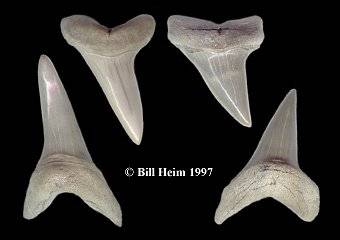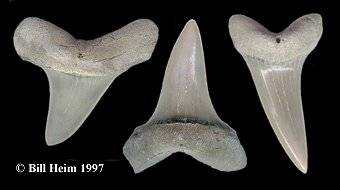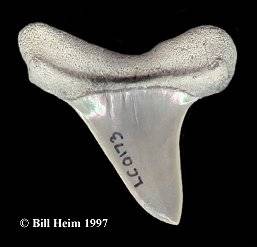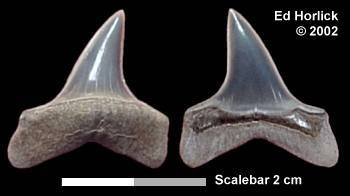| |

 Prior to the acceptance of Cosmopolitodus,
certain Lee Creek (and other fossil) teeth were grouped as the 'broad' or
'narrow'-toothed makos. Many now accept that the broad-toothed taxa are great
whites. The remaining narrow-toothed species have their own controversy, do
they represent an extinct or extant taxa. Traditionally, Lee Creek teeth were
ascribed to the extinct species Isurus desori
(SISMONDA, 1849) and I. retroflexus (AGASSIZ, 1843).
Those seeing these teeth as representing the presence of extant species in the fauna,
identify them as I. oxyrinchus RAFINESQUE, 1809 (Shortfin Mako)
and I. paucus GUITART MANDAY, 1966 (Longfin Mako) respectively.
Prior to the acceptance of Cosmopolitodus,
certain Lee Creek (and other fossil) teeth were grouped as the 'broad' or
'narrow'-toothed makos. Many now accept that the broad-toothed taxa are great
whites. The remaining narrow-toothed species have their own controversy, do
they represent an extinct or extant taxa. Traditionally, Lee Creek teeth were
ascribed to the extinct species Isurus desori
(SISMONDA, 1849) and I. retroflexus (AGASSIZ, 1843).
Those seeing these teeth as representing the presence of extant species in the fauna,
identify them as I. oxyrinchus RAFINESQUE, 1809 (Shortfin Mako)
and I. paucus GUITART MANDAY, 1966 (Longfin Mako) respectively.
 Purdy et al (2001) considered Isurus oxyrinchus to be present, but neither
I. retroflexus nor I. paucus to be represented in the Lee Creek
fauna. They went on to suggest that paucus may be a junior synonym of
C. hastalis.
Purdy et al (2001) considered Isurus oxyrinchus to be present, but neither
I. retroflexus nor I. paucus to be represented in the Lee Creek
fauna. They went on to suggest that paucus may be a junior synonym of
C. hastalis.
Mako teeth from Lee Creek are assigned by this page's authors to three 'species' —
Isurus oxyrinchus and the chrono-species I. retroflexus (Miocene - Pungo River)
& I. paucus (Pliocene - Yorktown Formation). (Note: If I. retroflexus were to be
equated to I. paucus, then the fossil name would have priority, an unusual, but not
unprecedented event.)
Teeth ascribed to Isurus oxyrinchus/desori are found in both the Pungo River and Yorktown
formations. As they increase in size, the teeth broaden, becoming somewhat like teeth of the
Cosmopolitodus species: xiphodon and hastalis.
This propensity to broaden is
also displayed by the I. retroflexus/paucus-type tooth, suggesting that unlike the juveniles
of each species, the adults fed upon a similar prey. The later species seems to have teeth with
roots which are more rounded and can be distinguished by a mesio-distal depression in the labial
face of the root adjacent to the base of the crown. In I. oxyrinchus, the distal cutting
edge of the anterior teeth do not reach the enamel shoulders of the root (in large lower anterior
teeth, they can come close). In I. paucus, the cutting edges of the anterior teeth
(uppers and lowers) are noticeably straighter and obviously reach the enamel shoulders of the root.
Isurus oxyrinchus RAFINESQUE, 1809
aka
I. desori (SISMONDA, 1849)
 |
Fig. 1 - Isurus oxyrinchus
lingual view of Yorktown specimens |
Isurus retroflexus (AGASSIZ, 1843) and/or
I. paucus GUITART MANDAY, 1966
 |
Fig. 2 - Isurus retroflexus/paucus
lingual view, 2 Yorktown (paucus) uppers
and a Pungo River (retroflexus) lower tooth |
 |
Fig. 3 - Isurus paucus
labial view of Yorktown specimen |
 |
| Fig. 4 - Isurus retroflexus |
|




